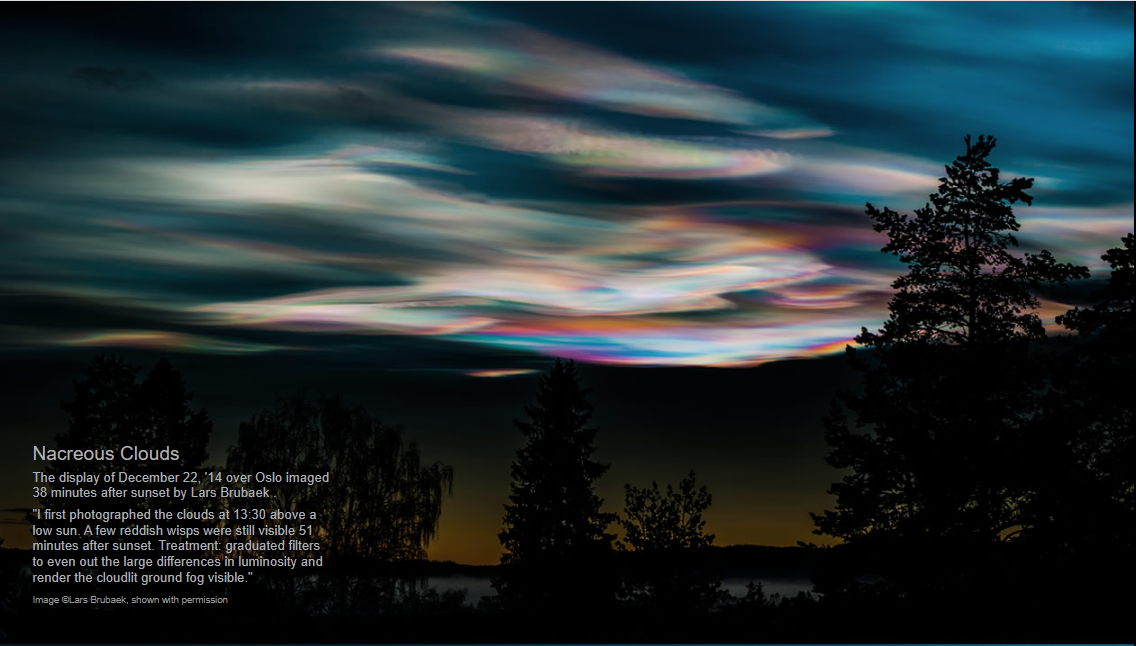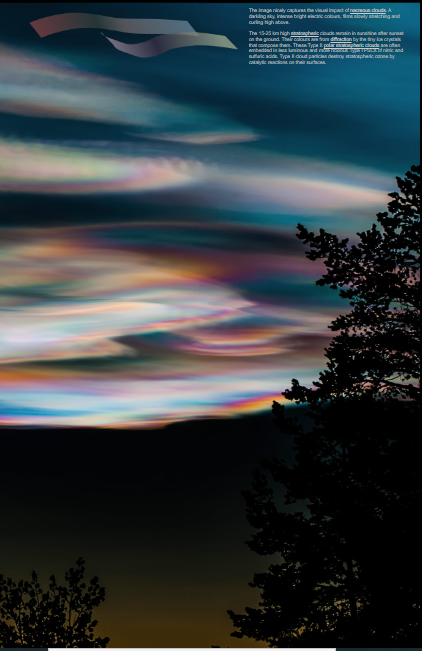Nacreous clouds, Norway - OPOD
Nacreous Clouds: A Spectacular Atmospheric Phenomenon in Norway
Nacreous clouds, also known as polar stratospheric clouds (PSCs), are a captivating atmospheric phenomenon that can be observed in certain regions of the world, including Norway. These clouds form at high altitudes, typically between 15 to 25 kilometers above the Earth's surface, in the stratosphere. Unlike most clouds that exist in the troposphere, nacreous clouds are found in the polar regions and are characterized by their stunning visual display.
The Visual Impact of Nacreous Clouds
Capturing the essence of nacreous clouds is a challenging task, but an image taken over Oslo on December 22, '14 by Lars Brubaek beautifully showcases their visual impact. In the photograph, a darkling sky contrasts with intense bright electric colors, creating a mesmerizing sight. The cloud formations appear as films that slowly stretch and curl high above, adding an element of dynamism to the scene.
The Science Behind Nacreous Clouds
The vibrant colors exhibited by nacreous clouds are a result of diffraction caused by the tiny ice crystals that make up these clouds. As sunlight passes through these ice crystals, it is scattered in different directions, leading to the appearance of vivid hues. However, it is important to note that nacreous clouds are often embedded within a layer of Type I polar stratospheric clouds (PSCs) composed of nitric and sulfuric acids. These Type I PSCs are less luminous and more noxious compared to their Type II counterparts.
The Environmental Impact of Nacreous Clouds
While nacreous clouds are undeniably beautiful, they also have a significant impact on the environment. Type II cloud particles, which constitute nacreous clouds, can catalyze reactions on their surfaces that lead to the destruction of stratospheric ozone. This destruction occurs through a process known as catalytic reactions, where the cloud particles facilitate chemical reactions that deplete the ozone layer. As a result, nacreous clouds play a role in ozone depletion, which has far-reaching implications for the Earth's atmosphere.
Nacreous Clouds in Norway
Norway is one of the prime locations to witness the spectacle of nacreous clouds. The country's geographical position, with its proximity to the polar regions, creates favorable conditions for the formation of these atmospheric wonders. During certain times of the year, particularly in winter, when temperatures drop significantly, the stage is set for the appearance of nacreous clouds in the Norwegian skies.
The Time of Observation
Observing nacreous clouds requires careful timing. In Lars Brubaek's photograph, the clouds were captured 38 minutes after sunset. It is worth noting that nacreous clouds often persist in sunlight even after sunset on the ground. This unique characteristic allows for prolonged visibility and enhances the chances of witnessing these ethereal formations.
The Importance of Graduated Filters
To accurately capture the intricate details and luminosity differences in nacreous clouds, photographers often utilize graduated filters. These filters help to even out the large variations in luminosity within the scene, allowing for a more balanced representation of the cloudlit ground fog. By using graduated filters, photographers can enhance the visibility of subtle elements that contribute to the overall beauty of nacreous clouds.
Appreciating Nacreous Clouds Safely
While nacreous clouds offer a captivating spectacle, it is important to remember that observing them safely is paramount. It is recommended to view these clouds from a safe distance and avoid staring directly at the sun, as it can cause damage to the eyes. Additionally, it is advisable to seek professional guidance or join organized tours led by experienced individuals who can provide valuable insights and ensure a safe and enjoyable experience.
Conclusion
Nacreous clouds are a breathtaking atmospheric phenomenon that adds a touch of magic to the skies of Norway. Their vibrant colors, dynamic formations, and unique characteristics make them a sight to behold. However, it is crucial to recognize their environmental impact and the role they play in ozone depletion. By appreciating nacreous clouds responsibly and understanding their scientific significance, we can fully embrace the wonders of our planet's atmosphere. So, keep your eyes to the sky and be ready to witness the awe-inspiring beauty of nacreous clouds when nature puts on its most extraordinary display.

Nacreous Clouds
The display of December 22, '14 over Oslo imaged 38 minutes after sunset by Lars Brubaek .
"I first photographed the clouds at 13:30 above a low sun. A few reddish wisps were still visible 51 minutes after sunset. Treatment: graduated filters to even out the large differences in luminosity and render the cloudlit ground fog visible."
Image ©Lars Brubaek, shown with permission

The image nicely captures the visual impact of nacreous clouds. A darkling sky, intense bright electric colours, films slowly stretching and curling high above.
The 15-25 km high stratospheric clouds remain in sunshine after sunset on the ground. Their colours are from diffraction by the tiny ice crystals that compose them. These Type II polar stratospheric clouds are often embedded in less luminous and more noxious Type I PSCs of nitric and sulfuric acids. Type II cloud particles destroy stratospheric ozone by catalytic reactions on their surfaces.
Note: this article has been automatically converted from the old site and may not appear as intended. You can find the original article here.
Reference Atmospheric Optics
If you use any of the definitions, information, or data presented on Atmospheric Optics, please copy the link or reference below to properly credit us as the reference source. Thank you!
-
<a href="https://atoptics.co.uk/blog/nacreous-clouds-norway-opod-2/">Nacreous clouds, Norway - OPOD</a>
-
"Nacreous clouds, Norway - OPOD". Atmospheric Optics. Accessed on November 26, 2024. https://atoptics.co.uk/blog/nacreous-clouds-norway-opod-2/.
-
"Nacreous clouds, Norway - OPOD". Atmospheric Optics, https://atoptics.co.uk/blog/nacreous-clouds-norway-opod-2/. Accessed 26 November, 2024
-
Nacreous clouds, Norway - OPOD. Atmospheric Optics. Retrieved from https://atoptics.co.uk/blog/nacreous-clouds-norway-opod-2/.